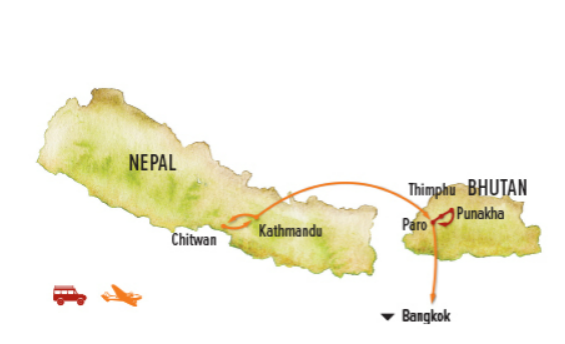Overview
Geographically diverse Nepal holds the world’s highest mountains and lowland jungle plains. Safaris in the Terai reveal its captivating wildlife as we search for rhinos, sloth bears and leopards roaming the subtropical forests. In neighboring Bhutan, quality of life is measured in terms of Gross National Happiness, not merely material measures. Though Bhutan is a tiny country, it is a global conservation leader, proud to be not only carbon-neutral, but carbon-negative. The “Land of the Thunder Dragon” remains dedicated to preserving its deep Buddhist traditions and pristine landscapes. Visitor presence is still light, and a journey among its serene monasteries, Himalayan peaks, glacial rivers and peaceable villages reveals Bhutan’s singular beauty. Combine an adventure in these two ancient kingdoms for a nature sojourn that will move your spirit.
Trip Highlights
- A Diverse Experience of Contrasting Natural Realms On this insider’s discovery of two neighboring countries, find a distinctive focus on nature, scenery, wildlife and varied ecosystems, from tropical lowlands to subalpine heights
- Jungle Wildlife Safaris in Chitwan National Park Explore the UNESCO World Heritage Site of Chitwan, home to Asian elephants, one-horned rhinoceros, sloth bear, spotted deer, golden jackal, profuse birdlife and more
- Encounters with Ancient Cultural Heritage Visit the temples of the Kathmandu Valley, and hike to Taktsang Monastery, Bhutan's famous “Tiger’s Nest” temple perched half a mile up on a sheer mountain cliff
Itinerary
Please fill out the form below to request a quote for rates.
Included
- Trip price includes: Accommodations, services of Nat Hab's professional Expedition Leader(s) and local guides, all meals from dinner on Day 1 through breakfast on final day, some gratuities, airport transfers on Day 1 and final day (in Bhutan only), all activities and entrance fees, all taxes, permits and service fees.
- Internal air cost includes: All flights within the itinerary (this will be listed separately on our invoicing).
Not Included
- Travel to and from the start and end point of your trip, alcoholic beverages, some gratuities, passport and Nepal visa fees, optional activities, items of a personal nature (phone calls, laundry and internet, etc.), airline baggage fees, required medical evacuation insurance, optional travel protection insurance.
Map











